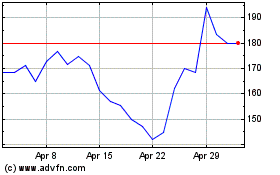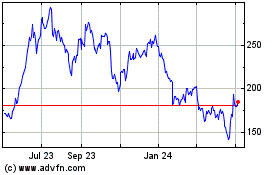What's Driving Everything From a Market Frenzy to an Embrace of U.S. Deficits? Magical Thinking.
January 30 2021 - 11:04AM
Dow Jones News
By Greg Ip
The Wall Street bulls embracing sky-high stock values and the
Washington pols embracing big deficits may be ideological
opposites, but they have something important in common. Both draw
sustenance from near-zero interest rates which make stocks more
valuable and debt more supportable. And both risk taking this
basically sound logic to extremes.
The rally in everything from big tech stocks to Tesla Inc. to
bitcoin are all manifestations of what Wall Street calls "TINA" for
"there is no alternative": when bank deposits pay nothing and
government bonds next to nothing, investors will grasp at almost
anything in search of a return.
Directionally, this is not wrong. The value of an asset is its
future income, discounted to the present using interest rates, plus
a "risk premium" -- the extra return you expect for owning
something riskier than a government bond. A declining interest rate
or risk premium boosts the present value of that future income.
This can certainly justify some of the market's rally. The ratio
of the S&P 500 to expected earnings has jumped from 18 in 2019
to 22 now, lowering the inverse of that ratio, the "earnings
yield," from about 5.5% to 4.6%. That happens to closely track the
decline in the 10-year Treasury yield from 1.9% to around 1%. Low
rates also help explain the outperformance of big growth companies
like Apple Inc. and Amazon.com Inc., for whom the bulk of profits
lie far in the future.
Has this gone too far? In a blog post Aswath Damodaran, a New
York University finance professor, worked out the intrinsic value
of the S&P 500 assuming bond yields at 2% over the long run and
an equity risk premium of 5%. The result: The S&P on Friday was
roughly 11% overvalued.
Maybe that's not bubble territory, but it's definitely
expensive. And while you can justify the overall market level with
moderately bullish assumptions, you need ever more contrived
arguments as the spotlight moves to individual sectors and
stocks.
To justify Apple's current value, you need a lot of confidence
about how the next few years will turn out. To justify Tesla's, you
need a lot of confidence about the next few decades. To justify
GameStop's -- well, has anyone who bought it recently thought
beyond the next few days?
The same low-rate logic fueling the everything rally has now
found its way into the fiscal debate in Washington. Congress in the
last year has borrowed roughly $3.4 trillion to combat the pandemic
and its economic fallout, and President Biden has proposed
borrowing $1.9 trillion more. These sums would together equal
roughly 25% of gross domestic product -- the largest burst of
national borrowing since World War II.
In advocating for this package, Mr. Biden and Treasury Secretary
Janet Yellen note that interest rates are historically low. Despite
this added debt, interest expense won't be much higher as a share
of GDP than a few years ago. The Federal Reserve says it will keep
short-term rates near zero for several years to get unemployment
down and inflation up. If it succeeds, that's great news for stock
bulls and debt doves.
In her confirmation hearing, Ms. Yellen cautioned that the U.S.
debt trajectory is a "cause for concern." Budget deficits must be
brought down to levels that stabilize the debt in the "longer
term," she said, meaning that's a problem to address another
day.
As with the stock market, the problem here isn't with Ms.
Yellen's fairly conventional take on interest rates and debt, but
with others who go even further. They argue there is no limit to
how much the U.S. can borrow: It can always repay the debt by
printing more dollars, and dispute that more debt must lead to
higher rates, noting rates have fallen as debts have risen in the
last decade. Thus, they argue, Mr. Biden must not let alarmist
rhetoric about the debt hold back funding for his priorities on
inequality, climate, and health care, nor worry if some spending
isn't particularly effective such as $1,400 checks to affluent
families who will simply save it.
Yet this logic assumes interest rates are somehow independent of
the level of debt. In fact, there is some level of borrowing that
would eventually push up inflation and interest rates. No one knows
what that level is, though it has clearly risen because private
borrowing has been depressed. But if the U.S. proceeds as if no
limit exists, it is more likely to hit it. "Inflation might be a
greater danger precisely because it's no longer perceived as such,"
former Federal Reserve official Bill Dudley wrote last year.
Finally, how much debt the U.S. can carry depends not just on
interest rates but on GDP. Indeed rates were low even before the
pandemic because GDP growth had been trending down, perhaps due to
aging populations world-wide. To be sure, well targeted stimulus
now should speed up recovery, helping the economy's debt-carrying
capacity. On the other hand, the U.S. has also experienced two
economic disasters within 12 years of each other, which pushed down
the path of GDP and pushed up debt. However much fiscal space the
U.S. has, responding to those disasters has consumed quite a bit of
it: Federal debt has risen from 35% to over 100% of GDP since
2007.
It might want to keep some fiscal space in reserve in case of
another disaster.
Write to Greg Ip at greg.ip@wsj.com
(END) Dow Jones Newswires
January 30, 2021 10:49 ET (15:49 GMT)
Copyright (c) 2021 Dow Jones & Company, Inc.
Tesla (NASDAQ:TSLA)
Historical Stock Chart
From Dec 2024 to Jan 2025

Tesla (NASDAQ:TSLA)
Historical Stock Chart
From Jan 2024 to Jan 2025
